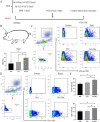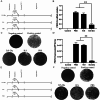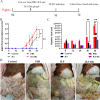Feeding with 4,4'-diaponeurosporene-producing Bacillus subtilis enhances the lactogenic immunity of sow
- PMID: 38115003
- PMCID: PMC10729370
- DOI: 10.1186/s12917-023-03846-3
Feeding with 4,4'-diaponeurosporene-producing Bacillus subtilis enhances the lactogenic immunity of sow
Abstract
Specific antibodies produced sow by oral porcine epidemic diarrhea virus (PEDV) vaccines would transfer to newborn piglets via colostrum, and it is an effective strategy to prevent porcine epidemic diarrhea (PED). However, there is a lag in the development of corresponding vaccines due to the rapid mutation of PEDV, which could increase the difficulty of PED prevention and control in pig farms. Hence, congenital lactogenic immunity was assessed by feeding 4,4'-diaponeurosporene-producing Bacillus subtilis (B.S-Dia) to sow on the 80th day of gestation in order to protect newborn piglets from PEDV infection. Firstly, we found that the quantities of T lymphocytes and monocytes in the blood and colostrum after oral administration of B.S-Dia were significantly increased as observed by flow cytometry, whereas the proliferative activity of T lymphocytes in colostrum was also markedly increased. Furthermore, enzyme-linked immunosorbent assay (ELISA) results revealed that levels of TGF (Transforming growth factor) -β, Interleukin (IL) -6, lysozyme and lactoferrin were significantly increased. Finally, it was found in the piglets' challenge protection test that offspring pigs of the sows feeding B.S-Dia during pregnancy did not develop diarrhea symptoms and intestinal pathological changes at 48 h after infection with PEDV, and PEDV load in the jejunum and ileum was significantly reduced, but offspring pigs of the sows taking orally PBS during pregnancy developed pronounced diarrhea symptoms and extensive PEDV colonization was noted both in the jejunum and ileum. In summary, sow by oral administration of B.S-Dia substantially increased congenital lactogenic immunity, thereby preventing newborn piglets from being infected with PEDV.
Keywords: 4,4′-diaponeurosporene-producing Bacillus subtilis (B.S-Dia); Congenital lactogenic immunity; Cytokines; Lysozyme and lactoferrin; PEDV.
© 2023. The Author(s).
Conflict of interest statement
The authors have declared that no competing interests exist.
Figures







Similar articles
-
Maternal immunization and vitamin A sufficiency impact sow primary adaptive immunity and passive protection to nursing piglets against porcine epidemic diarrhea virus infection.Front Immunol. 2024 May 15;15:1397118. doi: 10.3389/fimmu.2024.1397118. eCollection 2024. Front Immunol. 2024. PMID: 38812505 Free PMC article.
-
S1 domain of the porcine epidemic diarrhea virus spike protein as a vaccine antigen.Virol J. 2016 Apr 1;13:57. doi: 10.1186/s12985-016-0512-8. Virol J. 2016. PMID: 27036203 Free PMC article.
-
Stage of Gestation at Porcine Epidemic Diarrhea Virus Infection of Pregnant Swine Impacts Maternal Immunity and Lactogenic Immune Protection of Neonatal Suckling Piglets.Front Immunol. 2019 Apr 24;10:727. doi: 10.3389/fimmu.2019.00727. eCollection 2019. Front Immunol. 2019. PMID: 31068924 Free PMC article.
-
Lactogenic immunity and vaccines for porcine epidemic diarrhea virus (PEDV): Historical and current concepts.Virus Res. 2016 Dec 2;226:93-107. doi: 10.1016/j.virusres.2016.05.016. Epub 2016 May 19. Virus Res. 2016. PMID: 27212686 Free PMC article. Review.
-
Porcine epidemic diarrhea virus (PEDV): An update on etiology, transmission, pathogenesis, and prevention and control.Virus Res. 2020 Sep;286:198045. doi: 10.1016/j.virusres.2020.198045. Epub 2020 Jun 2. Virus Res. 2020. PMID: 32502552 Free PMC article. Review.
Cited by
-
Prolactin promotes transepithelial migration of lymphocytes through CCL2.Poult Sci. 2025 Aug;104(8):105322. doi: 10.1016/j.psj.2025.105322. Epub 2025 May 20. Poult Sci. 2025. PMID: 40446683 Free PMC article.
-
Bacillus subtilis Fed to Sows Promotes Intestinal Development and Regulates Mucosal Immunity in Offspring.Vet Sci. 2025 May 18;12(5):489. doi: 10.3390/vetsci12050489. Vet Sci. 2025. PMID: 40431582 Free PMC article.
-
Advances research in porcine enteric coronavirus therapies and antiviral drugs.Vet Q. 2024 Dec;44(1):1-49. doi: 10.1080/01652176.2024.2421299. Epub 2024 Nov 1. Vet Q. 2024. PMID: 39484691 Free PMC article. Review.
-
Nuclear shuttling of CDC4 mediated broad-spectrum antiviral activity against diverse coronaviruses.Emerg Microbes Infect. 2025 Dec;14(1):2493922. doi: 10.1080/22221751.2025.2493922. Epub 2025 May 6. Emerg Microbes Infect. 2025. PMID: 40260685 Free PMC article.
References
-
- Cabinian A, Sinsimer D, Tang M, Zumba O, Mehta H, Toma A, Sant’Angelo D, Laouar Y, Laouar A. Transfer of maternal Immune cells by Breastfeeding: maternal cytotoxic T lymphocytes present in breast milk localize in the Peyer’s patches of the Nursed Infant. PLoS ONE. 2016;11(6):e0156762. doi: 10.1371/journal.pone.0156762. - DOI - PMC - PubMed
-
- Langel SN, Paim FC, Alhamo MA, Buckley A, Van Geelen A, Lager KM, Vlasova AN, Saif LJ. Stage of Gestation at Porcine Epidemic Diarrhea Virus Infection of pregnant swine impacts maternal immunity and lactogenic Immune Protection of neonatal suckling piglets. Front Immunol. 2019;10:727. doi: 10.3389/fimmu.2019.00727. - DOI - PMC - PubMed
MeSH terms
Substances
Grants and funding
LinkOut - more resources
Full Text Sources
Medical

